Menus
- Suter MMX 500 in the PS test
- Suter MMX 500 for 120,000 Swiss francs
- 195 hp at just 127 kilograms
- "Suter MMX 500 is a pure racing motorcycle"
- Low weight as the biggest disadvantage
- "I’m not good for a PR campaign"
- Technical data Suter MMX 500
- Mat Oxley on two-stroke
- Two-stroke versus four-stroke in MotoGP
- "Today the man with the calculator has us in hand"
- Racing five to six times more expensive
- There is no scientific argument against two-stroke engines

Marco Zamponi


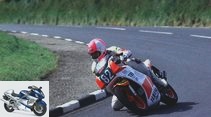

14th photos
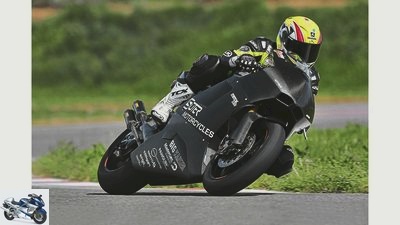
Marco Zamponi
1/14
Picture gallery, sport: The Suter MMX 500 is to show on the Isle of Man that the two-stroke engines still have a future.
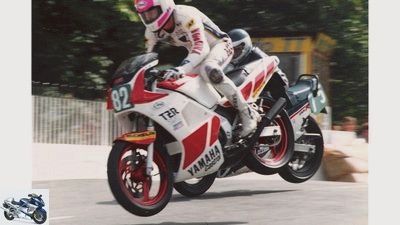
2/14
Mat Oxley in the 1990s with the Yamaha TZR 250 at the TT.
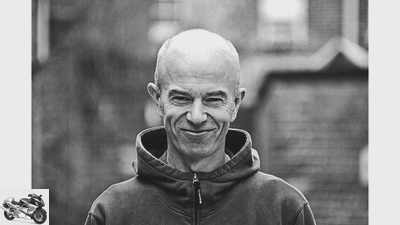
3/14
Max Oxley, TT winner and PS sports editor also dreams of a future for the two-stroke engine.
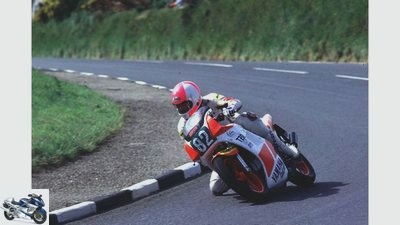
4/14
Mat Oxley in the 1990s with the Yamaha TZR 250 at the TT.

Davision
5/14
Ian Lougher’s last two-stroke race on the Isle of Man was 17 years ago. In 2016 he started with the Suter MMX 500 in the Senior TT and finished 34th.
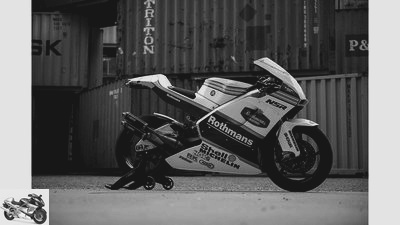
Dave Roth
6/14
For a possible road approval of such a motorcycle, however, direct injection is planned for future production steps. Eskil Suter is sure to achieve the emission values of Euro 4 and also to significantly reduce fuel consumption.
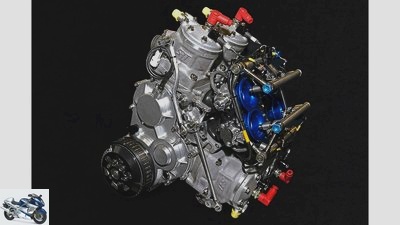
Friedemann Kirn
7/14
A fascinating V4 engine: you can clearly see the intake manifold injection above the blue intake funnel.
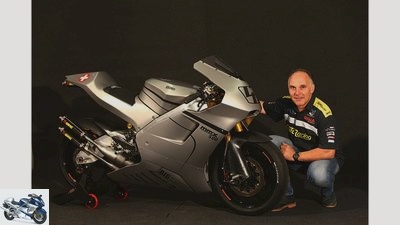
Friedemann Kirn
8/14
The intake manifold injection used by Suter also facilitates maintenance and engine tuning. While the old two-stroke engines were much more temperature-sensitive due to their technology with the carburettors and the machines had to be jetted accordingly, the gasoline-air mixture is now permanently optimized via the injection system using a sensor.

Friedemann Kirn
9/14
Two counter-rotating crankshafts to balance the inertia forces.
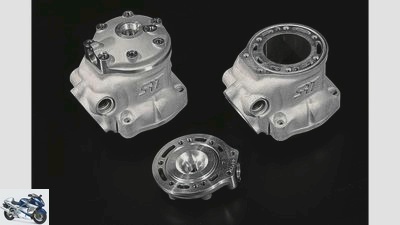
Friedemann Kirn
10/14
Another world: apart from the spark plug and the sensor, the cylinder heads of the two-stroke four-cylinder engine do not contain any components worth mentioning.
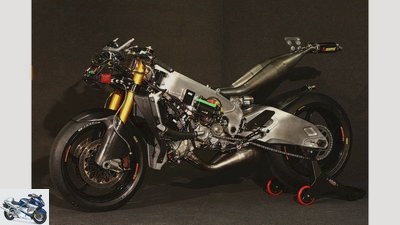
Friedemann Kirn
11/14
… And that with a weight of only 127 kg.
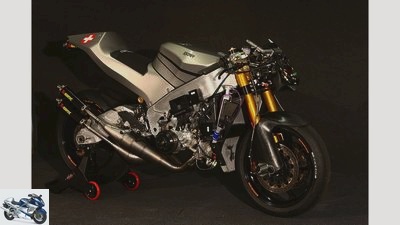
Friedemann Kirn
12/14
The 576 cm³ four-cylinder two-stroke V engine delivers around 195 hp at 13,000 rpm. …
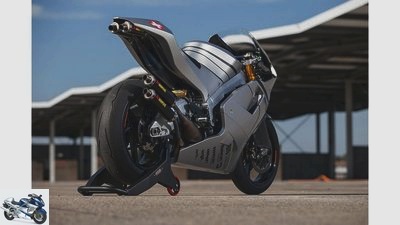
Friedemann Kirn
13/14
The idea was born six months ago: Suter’s new MMX 500 will compete in the TT this year, in the king’s race, the senior TT, and Ian Lougher will be in the saddle.

14/14
In 20 years we will be with the electric motor anyway, then everyone will say: Oh, how awesome the combustion engines were. But that’s the future. Is that it??
Compete in the TT with a two-stroke engine
Suter MMX 500 in the PS test
Content of
The Swiss racing forge Suter wants to revive the two-stroke. On the Isle of Man, the Suter MMX 500 is supposed to show that the concept has a future.
"At first I thought it was a joke", laughs Ian Lougher. After all, the ten-time TT winner had ended his driving career in 2013. But more importantly, it was 17 years ago that he last raced a two-stroke engine on the Isle of Man. “I drove an NSR 500 and came third in the Senior TT.” But those days are long gone. Back then, the lap record was 124 mph on average. Today it is almost 133 miles or 214 km / h with the four-stroke superbikes. Two-stroke engines have long since stopped taking part in the world’s most famous road race. So it’s no wonder that Ian Lougher thought the question whether he would like to drive this year’s TT with the Suter MMX 500 was a joke.
Buy complete article
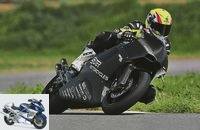
Compete in the TT with a two-stroke engine
Suter MMX 500 in the PS test
Ian trusts SRT’s professionalism
“Ultimately, the passion at SRT convinced me,” says Lougher, who is now 53 years old. After Suter’s first inquiry, he met the team and the Suter MMX 500 for the first time at the Zurich motorcycle fair at the beginning of the year – and was electrified: “The team is made up of 100 percent real racing enthusiasts, extremely professional, and the MMX is really one fascinating motorcycle, ”said the Welshman. “They explained everything to me, the technical solutions and what exactly they are up to. My wife then asked me whether I would rather regret competing in the TT again or not ride the bike. I immediately accepted. “
Lougher does not feel like a guinea pig, although at the time of his decision he had not yet driven a single meter with the Suter MMX 500. He trusts the professionalism of SRT, which has already won world championship titles, for example in the Moto2 Grand Prix, and produces top-quality racing technology.
Suter MMX 500 for 120,000 Swiss francs
In addition, Lougher sees no problem in being able to compete successfully in the TT with a supposedly outdated technology like the two-stroke: “I am convinced that the end of the two-stroke came much too early and it was simply wrong, they no longer to be developed. ”Lougher thinks it is entirely possible that the Suter MMX 500, which is technically considerably improved compared to the earlier two-stroke machines, could be victorious in a TT race. Maybe not in the first year, but right now the team plans to develop the MMX over about three years.
The motorcycle currently corresponds exactly to the limited batch of 99 machines that SRT builds for an exclusive clientele and sells for 120,000 Swiss francs (around 110,000 euros). For the special requirements on the Isle of Man, the Suter MMX 500 still has to be adapted accordingly. “The motorcycle is filigree and light,” says Philippe Soutter. “The technical experience that we will gain during the TT will flow one-to-one into the further production of the two-stroke.”
Ian is said to play a major role in this. Not only as a pilot, but also on the TT because he knows the island and the course very well and is also very well informed about the logistics: “I asked those responsible what expectations they had when they come to the TT, because I had no desire to dream of any kind to sit up. They told me that it was only important to them that I drive the Suter MMX 500 there and give feedback. Then you see further. You can build on this attitude. “
195 hp at just 127 kilograms
The key data of the Suter MMX 500 are anything but bad for an ambitious start at the TT. In order to curb the wild life of the previously known 500 series, the MMX motor has two counter-rotating crankshafts. The four-cylinder V-engine also blows the original 500cc displacement by 76 cm³. Because of the standard 56 millimeter piston diameter for the large two-stroke piston, the stroke had to be adjusted to 58.5 millimeters. “If the stroke is too large, you will have problems with the piston speed; if the stroke is too small, torque is lost because of the flushing losses,” explains Eskil Suter, explaining the displacement of 576 cm³. “With this measure, we have eliminated the torque hole of the old 500.” The two-stroke engine should also now produce a fat 195 hp. The whole motorcycle weighs just 127 kilograms. This means that the MMX 500 competes against superbikes with over 200 hp and weighing more than 180 kilos. The power-to-weight ratio speaks for the Suter.
But the Mountain Course is not a Grand Prix circuit. “That will be the biggest problem,” says Ian Lougher in an interview with PS before the first roll-out. “A light but fast machine like the Suter MMX 500 naturally has more problems on the straight sections of the TT with the many rough jumps and jumps than the heavier four-stroke superbikes because it will be more difficult to keep on course, more slips and jumps. On the other hand, it is more forgiving because of the significantly lower weight, so that I don’t really have to take off the gas. “
"Suter MMX 500 is a pure racing motorcycle"
On the other hand, Lougher is certain that he will be able to fully enjoy the advantages of the Suter MMX 500 in the winding sections, for example around Glen Helen or up into the mountains behind Ramsey. “Due to my stature, I always had to struggle with the superbikes through the corners, especially in fast alternating corners. This will be a lot easier for me with this 127 kilo motorcycle. Changes in direction have always been the strength of the two-stroke engine. “
And if the Suter should reliably cover the senior distance of six laps and thus more than 360 kilometers, Lougher will be able to benefit from the fact that the bike will not wear him out so much. For him, the advantages and disadvantages of driving characteristics are roughly balanced. The training week is important, which is why Ian is hoping for the best weather to get enough driving time for the perfect set-up of the Suter MMX 500.
A week later we speak to Lougher again. Now he has driven the Suter MMX 500 on the small Vairano circuit near Milan. The likeable Briton is still enthusiastic about his TT motorcycle – and more optimistic than ever. He not only immediately felt comfortable in the saddle, but also found the MMX to be very rideable: “It had absolutely nothing of the extreme wheelie tendency I know from old 500s.” Nevertheless, the MMX is a pure racing motorcycle that has none of the subservience of racing-trimmed street bikes. “When I got it right, she quickly showed me what makes her tick. If you don’t concentrate fully, this motorcycle will bite you. “
Low weight as the biggest disadvantage
He still identified the low weight as the biggest disadvantage: “Because the Suter MMX 500 is a pure racing bike, it fits perfectly on a normal racetrack. The Mountain Course does not attribute such radical motorcycles to their stiffness and low weight so easily. We’ll be spending a lot of time together in the air. “
On the other hand, Ian is enthusiastic about the handling of the Suter MMX 500, exactly as he expected. Change of direction is playful. He was also baffled by the injection. Something he doesn’t know about the two-stroke engine: “The injection technology for the two-stroke engine was only just emerging and died almost instantly with the disappearance of the bikes. Suter developed here for a long time. The connection from the throttle hand to acceleration is the most impressive. It’s so smooth and yet very direct, without any jerks or load changes – better than with any four-stroke engine. In addition, the power is distributed over the entire speed range. There is no such thing as a nasty kick or this extremely narrow performance band that grabs you at lightning speed like with the old two-stroke machines. “
"I’m not good for a PR campaign"
In addition to these driver-friendly properties, the intake manifold injection used by Suter also facilitates maintenance and engine tuning. While the old two-stroke engines were much more sensitive to temperature due to their technology with the carburettors and the machines had to be jetted accordingly, the gasoline-air mixture is now permanently optimized via the injection system using a sensor. However, at the moment the injection nozzles are still in the intake tract with one nozzle each in front of and behind the throttle valve. For a possible road approval of such a motorcycle, however, direct injection is planned for future production steps. Eskil Suter is sure to achieve the emission values of Euro 4 and also to significantly reduce fuel consumption.
Last but not least, Lougher praises the enormous torque, which is said to be even better than that of the Honda NSR 500. “The Suter MMX 500 may not turn as extremely freely upwards as the Honda did back then, but this motorcycle demands absolute respect.”
Another test should follow in Brno until training for the TT finally begins in the last week of May. Then the Suter MMX 500 has to show what it’s made of on the tough mountain course. Ian is looking forward to it and wants to attack: “I’m a racing driver. For a mere PR campaign to get the 99 copies to the people, I’m not good. If I’m going down Bray Hill there’ll be only one thing left: a decent result. ”No joke – Lougher and SRT are really serious.
Technical data Suter MMX 500
drive: Four-cylinder two-stroke V-engine, approx. 195 hp at 13,000 rpm, 576 cm³, bore / stroke: 56.0 / 58.5 mm, electronic fuel injection, 36 mm throttle valves, electronically controlled double-flap exhaust valves, Suter -Multi-plate dry clutch, SRT six-speed cassette transmission, chain.
landing gear: Aluminum bridge frame, steering head angle: 24.5 degrees (adjustable), caster: 110 mm, wheelbase: 1450 mm, Ohlins upside-down fork, fully adjustable.
Wheels and brakes: Magnesium or aluminum wheels, 3.75 x 17 / 6.00 x 17 (option Suter Penta Carbon), front tires: 125/75-R17, rear: 205/75-R17, 320 mm double disc brakes with Brembo four-piston brake calipers at the front, 218mm single disc with two-piston rear brake caliper.
Weight: 127 kg
Base price: approx. 110,000 euros
Mat Oxley on two-stroke
Mat Oxley
Mat Oxley in the 1990s with the Yamaha TZR 250 at the TT.
A two-stroke engine is the right engine for a racing motorcycle. How could it be any different? A two-stroke engine is smaller, lighter, cheaper and even more powerful than a four-stroke engine. And it has more torque – if you do it right. But they fell by the wayside in the 1980s and were swept off the streets in the US, Europe and later everywhere by increasingly stringent emissions laws. But there are many reasons why they could come back. Above all the latest technical developments.
The two-stroke motors were also abolished in racing by the GP marketer Dorna, the world association FIM and the association of motorcycle manufacturers. In 2002 the four-stroke engine came in MotoGP. However, the first 990 engine was only wafer-thinly faster than the still legal 500 two-stroke engine, which was completely banned a little later. Next, the 250s were due. The Moto3 was finally the end for the 125cc. All three classes have existed since the beginning of GP sport in 1949. But in a very short time they disappeared into the rubbish bin of history.
Two-stroke versus four-stroke in MotoGP
When both concepts competed against each other under the same rules, the two-stroke took off step by step in the 1960s. Mainly he owes this to one man: Walter Kaaden, an Air Force engineer during the Second World War, who later led the MZ racing department to world fame. The first title for the two-stroke engine was in 1962 for the 50s, the last for the four-stroke engine in 1974 for the 500s.
Valentino Rossi is the only active GP racing driver to have won both four-stroke and two-stroke in the premier class. His favorite bike? The two-stroke Honda NSR 500, with which he won the last 500cc title in 2001. “For me the two-stroke was better, although it was more difficult to ride compared to my bike today. The 500 power was wild back then. The two-strokes were also more difficult to set up. If it wasn’t 100 percent right, the bike was a disaster. With the four-stroke engine it got boring. ”Some of the racing legends agree. “With the two-stroke you have a direct connection between the throttle hand and what happens,” says Kevin Schwantz. “A unique feeling when you can do it well.”
"Today the man with the calculator has us in hand"
Four-time 500 world champion Eddie Lawson fondly remembers the two-stroke experiences with his technician Kel Carruthers: “The cool thing about the 500 was that Kel said, hey you know what? I’ll work the heads, ”Lawson laughs. “The Japanese just widened their eyes and nodded contrite. Today they take out their computers and simply reprogram the mapping. Back then, Kel grabbed a hammer, a chisel and such crap – wonderful! “
Most of the technicians who worked on both engines also miss the two-stroke engines because they had more intervention options. “There were some wonderful things you could do with the two-stroke set-up with them,” said Jeremy Burgess, who took 13 MotoGP titles as crew chief for Mick Doohan and Valentino Rossi. “We did that with the main jets, the needles, the whole kit and all that hodgepodge to get the engine perfect. Today the man with the computer has us completely in hand. “
Racing five to six times more expensive
I drove two and four-stroke engines myself. I took part in the TT with standard 250cc two-stroke engines and then 400cc four-stroke engines. The 250s were more fun. They were lighter and took these four-stroke myths to the point of absurdity that the two-stroke engines were too nervous, speed-oriented and difficult to drive. The Yamaha TZR 250 had an excellent torque with which one clicked easily out of every corner. When I then drove the FZR 400, it was really wrong in comparison: sluggish, more difficult to steer and the engine only went around at the top. Over the TT lap, the 400 was actually 6.5 km / h faster, but terribly boring – and more expensive too.
The four-stroke engines are so established today that their profitability is no longer discussed at all. They actually made racing dramatically more expensive. Wayne Gardner made a name for himself as a two-stroke and four-stroke champion, winning the 500 World Championship title in 1987 with the NSR 500 and several eight-hour races in Suzuka with the Honda RVF 750. Today he looks after his son Remy in the Spanish one Championship. “After the two-stroke era, racing has become five to six times more expensive,” calculates Gardner. “Finding sponsors is becoming more and more difficult. Therefore, the drivers have to raise the money themselves. The sums are astronomical. We’re talking about 250,000 euros for a reasonably competitive package in the Spanish championship. “
There is no scientific argument against two-stroke engines
Two-stroke engines are now considered dead in racing as well as on the road. “We see it differently. From a scientific point of view, there is no argument to write off the two-stroke technology, ”says former KTM racing boss Winfried Kerschhaggl, today Vice President of the US arm of the Austrian brand. “I do not consider a two-stroke KTM street motorcycle to be ruled out in the future.” The latest KTM sales figures reveal that a not inconsiderable number of cross and enduro riders are returning to two-stroke models after years of four-stroke dominance. “There are various reasons for this,” says Kerschhaggl. “The bikes are easy to ride at first. In addition, you can use power much better today than it was years ago. The cost is an issue. Two-stroke engines are much cheaper to buy and maintain. “
Direct injection is the magic word. The two-stroke injection developed by the Australian company Orbital Engineering has already been used in scooters from Aprilia, Piaggio, Peugeot and Kymco. In an environmental test by the Thai environmental authority, the two-stroke Kymco KDI 100 scooter with orbital injection came in second and outperformed dozen of four-stroke competitors in terms of consumption and emissions. Orbital wants to trigger a real renaissance with the further development of the two-stroke options and trump the four-stroke engines in all areas: environmentally, economically and in terms of performance. When comparing a 450cc engine with injection, sometimes as a two-stroke and sometimes as a four-stroke, the two-stroke variant achieved the same peak performance, but managed a higher torque and a wider torque plateau than the four-stroke. The engine also needed less oil and produced no more exhaust smoke and noises or hydrocarbons, carbon monoxide and nitrogen oxides. It’s also smaller, lighter, cheaper and uses less fuel.
But before the two-stroke fans jump up enthusiastically, here are a few final words from MotoGP champion Jorge Lorenzo: “In a way, I miss the two-strokes. But if the future is four-stroke, that’s the direction. In 20 years we will be with the electric motor anyway, then everyone will say: Oh, how awesome the combustion engines were. But that’s the future. ”It is?
Related articles
-
Suter two-stroke racing machine MMX 500
2snap 14 pictures Marco Zamponi 1/14 picture gallery, sport: The Suter MMX 500 is supposed to show on the Isle of Man that the two-stroke engine still has a future ….
-
KTM 300 EXC and KTM 500 EXC-F in the test
markus-jahn.com 11 pictures markus-jahn.com 1/11 The two-stroke engines are celebrating their comeback in off-road racing. MOTORRAD has the KTM 300 EXC and the 500 EXC-F …
-
Husqvarna FE 350 and Husqvarna TE 300i in a comparison test
Husqvarna FE 350 and Husqvarna TE 300i in the comparison test Cloudy to clear The days of blue two-stroke clouds are (almost) over. Because with…
-
Honda Gold Wing GL 1800 endurance test final balance
Jacek Bilski 34 pictures ADAC 1/34 I’ve never taken apart an engine that looked so good, here everything looks more like 5,000 than 63,000 …
-
fact comparison test Crosser in suspension It seems clear that the four-stroke crossers in the small class will soon take over the helm. But now?…
-
Test: Norton 18 H racing machine
Noll Test: Norton 18 H racing motorcycle of the 20s Contents of In the 20s, the Norton 18 H was one of the most successful half-liter machines – and …
-
Aprilia RS 250 test A question of timing Fast street bikes with two-stroke engines? There’s only little Aprilia left. And that too must …
-
Test Moto Guzzi Quota 1100 ES agricultural machine There it is again. Imperturbable. With an even bigger engine. Happy to travel. With outrageously rustic charm: …
-
Test Cagiva Gran Canyon 900 The power of feelings Forget the technical data, do not think in terms of ready-made patterns, forget terms like Enduro and …
-
Test BMW R 1200 C Chromodienradl The Bavarian version of the American dream – a motorcycle like Marianne Sagebrecht in “Out of Rosenheim”. They have…